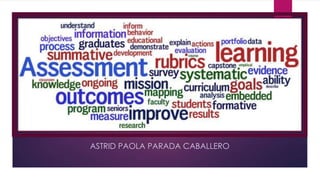
Testing, assessing,& teaching
- 1. ASTRID PAOLA PARADA CABALLERO
- 2. INTRODUCTION When I started reading this chapter I found it interesting because it talks about three essential components (testing, assessing, and teaching) we as a teachers should keep in our minds and have a wide knowledge of them in order to help our students to leave behind those fears, anxieties and self-doubts at the moment of facing a test. This article also helped to comprehended that assessment is not only about giving a grade but it is also about encourage students to learn from the weaknesses and strengths guiding their learning process in an individual way. there is brief interpretation of some important concepts I found out during my reading activity.
- 3. What is a test? It is a method of measuring person’s ability, knowledge or performance in a given domain. Method Measure It is an instrument, a set of techniques, procedures, or items. General ability: Multi-skill proficiency test Specific competences: A quiz in recognizing correct use of definite article
- 4. A test measures… o Individual’s ability, knowledge, and performance: Testers need to understand who the test-takers are, what are their experiences & background? How should test-takers interpret the results? Etc. o Performance: It means competence, the knowledge about the language NOT the one’s ability to perform a language( writing, listening, reading etc.) o Domain: It means overall proficiency of the language.
- 5. ASSESSMENT & TEACHING o Assessment: It is an outgoing process, the teacher subconsciously makes an assessment of the student performance while he/she answers a question, offers a comment, tries to speak or produce something new during the class. A good teacher never ceases to assess Ss. o Teaching: It provides the opportunities for learners to listen, think, takes risks, set goals, and process feedback from the coach to improve in their learning process. It also provides observation in students’ performance. OBSERVATION=TEACHER INSTRUCTION.
- 6. INFORMAL & FORMAL ASSESSMENT o Informal assessment can be: o Formal assessment: -Incidental, unplanned comment and responses. -Coaching & spontaneous feedback. - Give Ss' some strategies suggestions. -Example: very good! Good work! Nice job! it is systematic, it means that there are exercises or procedures designed to be focused on Ss achievements in terms of skills and knowledge.
- 7. FORMATIVE & SUMMATIVE ASSESSMENT o Formative assessment: o Summative assessment: It evaluates Ss in the process of forming their competences and skills with the goal of helping them to continue that growth process It evaluates SS at the end of the course and its aims is measure, or summarize what Ss have understood, how well Ss have accomplished the objectives.
- 8. NORM-REFORMED & CRITERIONREFORMED TESTS o Norm-Referenced tests: In these kind of tests each test-taker's score is interpreted in relation to a mean(average score, middle score, extent of variance scores). o criterion-referenced tests: The purpose is to place test-takers along a mathematical continuum in rank order. These kind of tests are designed to give test-takers feedback. Teachers spend more time and effort but they show interest in giving useful feedback to the Ss.
- 9. APPROACHES TO LANGUAGE TESTING: A BRIEF HISTORY 1950s:BEHAVIORISM Testing focused onspecific language elements such as the phonological, grammatical, and lexical contrasts between two languages. 1970s &1980s:COMMUNICATIVE THEORIES “The whole of the communicative event was considerably greater than the sum of its linguistic elements”
- 10. DESCRETE-POINT AND INTEGRATIVE TESTING o Discrete-point tests: It is based on the believed that language can be broken down into its components parts ( writing, listening, reading etc.)and those parts can be tested successfully. Cloze test: it taps into all of these abilities(knowledge of vocabulary, grammatical structure, reading skills and strategies etc.), which were said o integrative test: to be the essence of global language proficiency. Dictation test: It is an integrative test because it tap into grammatical and discourse competencies required for other modes of performance in a language. Unitary trait hypothesis: it suggested that language proficiency and the “four skills” shouldn’t be separated.
- 11. COMMUNICATIVE LANGUAGE TEACHING & PERFORMANCE-BASED ASSESSMENT Abandoned arguments about unitary trait o Communicative language teaching: hypothesis. Bachman &Palmer: strategic competence(the ability to employ communicative strategies) Real-world tasks. o Performance-based Assessment: It typically involves oral production, written production, open-ended responses, integrated performance among skills, and group performance. It is time-consuming and expensive but it is worth it.
- 12. CURRENT ISSUES IN CLASSROOM TESTING o New views on intelligence: o Traditional and “alternative” assessment: Gardner( 1832,1999)included 5 “frames of mind” Spatial intelligence. Musical intelligence. Body-kinesthetic intelligence. Interpersonal intelligence. Intrapersonal intelligence.
- 13. Advantages: Classroom- based testing. Self-directed testing on various aspects of the o Computer- based testing: language(vocabulary, grammar, discourse, etc.) Practicing for upcoming standardized tests. Disadvantages: Lack of security and the possibility of cheating. Occasional “home-grown” quizzes. Open-ended responses are less likely to appear. Human interactive element (oral production) is absent.